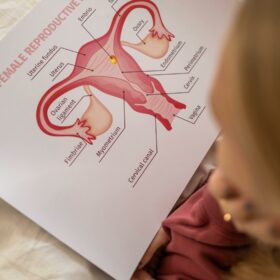
Types of fibroids
What's the lowdown?
Fibroids are muscular and connective tissue growths in the uterus
The 3 main types of fibroids are intramural, subserosal and submucosal. There are also pedunculated and cervical fibroids which are less common
Treatments can vary depending on the fibroid type, size and symptoms
Fibroids: the basics
When the muscle and connective tissue layer of your womb wall overgrows, it forms a fibroid. These growths are medically considered non-cancerous tumours and afflict 70% of assigned females at birth (AFABs) at some point in their lifetime1. Yes, 70%! Fibroids are far more common than you think.
Some people are at a higher risk of developing fibroids due to genetic risk factors or increased exposure to oestrogen.
There is a lot to cover about fibroids, but this article will focus on the different types of fibroids. If you are keen to read more about the causes, symptoms and treatments, head on over to our article on the basics of fibroids.
Types of fibroids
The 3 main types of fibroids are2:
- Intramural fibroids
- Subserosal fibroids
- Submucosal fibroids
You can also have pedunculated fibroids and cervical fibroids.
Let’s dive in!
Intramural fibroids
This is the most common type of fibroid. They develop inside the muscle wall of the uterus.
Subserosal fibroids
When a fibroid grows on the outside wall of the uterus, it is referred to as a subserosal fibroid. This type can grow very large and also contribute to obstructive symptoms like pelvic or back pain, and needing to urinate more (the fibroid puts pressure on the bladder) as it can protrude into the pelvic area.
Submusocal fibroids
These fibroids are a little more complicated. They grow in the muscle layer but beneath the inner lining of the uterus, growing into the cavity of the uterus. Infertility is rarely caused by fibroids unless extremely large in size. However, as submucosal fibroids grow into the uterus, they are more likely to affect fertility as they might block fallopian tubes, preventing the egg from reaching the uterus3.
Pedunculated fibroids
Pedunculated fibroids are not a type of fibroid, but a subset. Only the subserosal and submucosal fibroids can become pedunculated. But what is pedunculated? If the fibroid is hanging by a small stalk of tissue, it is referred to as a pedunculated fibroid.
Cervical fibroids
As the name suggests, this fibroid grows from the cervix. This is a rarer type, making up 0.6% of all fibroids4.
Describing the types of fibroids without using some medical terminology is tough. But to make things easier, here is an image so you can visualise and better understand the fibroid types.
Treating fibroids
The treatments of fibroids have come far and wide. Depending on the symptoms, size or location of the fibroids, your GP or specialist can offer you medications, hormonal contraception, and surgical or non-surgical procedures. There is a lot to understand about fibroid treatments so we have dedicated an article just to guide you through this topic.
Generally, medication or hormonal contraception is tried first.
If this fails or the fibroids are larger than 3cm, you will be referred to a gynaecologist (specialist) who will navigate the more intensive treatment options with you.
Not all fibroids need to be removed, some might not even cause any pesky symptoms. So you might just need to keep an eye on it. Mild symptoms might resolve with oral medication or contraception.
Surgical options are usually reserved for large fibroids or ones causing moderate to severe symptoms.
It is very overwhelming to know which treatment option might be right for you. We have a contraception recommender to make this choice easier, or you can open up to our women’s health GP. We are here to listen and support.

Summary
Fibroids come in all shapes and sizes. You can also have multiple fibroids. Unless bothering you with uncomfortable symptoms, not all fibroids need to be treated. There is no one-size-fits-all treatment for fibroids. It will be tailored to your needs and symptoms with the main aim of improving your quality of life!
We have just covered a small aspect of fibroids. To stay up-to-date on our latest fibroid articles, and the latest news and research in women’s health, sign up to our newsletter today!
Our medical review process
This article has been medically reviewed for factual and up to date information by a Lowdown doctor.





